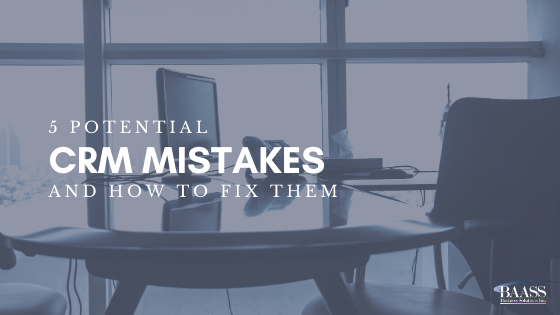 Launching a new CRM system is an exciting time in a company. At last, you’ve got the tools you need to reach customers, communicate effectively, prepare engaging marketing programs, and synchronize it all with the rest of the company’s data. But don’t breathe a sigh of relief just yet. There are still a few more tasks to tackle before you can say that your CRM project is complete.
Launching a new CRM system is an exciting time in a company. At last, you’ve got the tools you need to reach customers, communicate effectively, prepare engaging marketing programs, and synchronize it all with the rest of the company’s data. But don’t breathe a sigh of relief just yet. There are still a few more tasks to tackle before you can say that your CRM project is complete.
There are several mistakes that companies make when launching a new CRM system. Just knowing that these mistakes exist can help you avoid them. It’s sort of like getting the traffic report before you head off to work - if you know there’s a traffic jam on one road, you can plan accordingly to move around it, through it, or wait until it clears.
The same goes for CRM mistakes. If you know they’re out there, you can plan to work around them, through them, or avoid them entirely.
Five CRM Mistakes and the Fixes You Need to Know
The most common mistakes companies make when choosing and launching a CRM system include:
- Choosing a system without involving the end-users: Many companies assign the IT or sales teams with selecting a CRM system. While that sounds fine, there are other people in the company who will rely upon the CRM system.
This includes customer service, marketing, and perhaps a separate call center who will update the system. Invite representatives from each end-user department to the table to review the spec documents for the CRM project, and involve them in the vendor selection process. The more you can involve everyone who will eventually use the system in the choice of the system, the more invested they will feel in its success, and the more likely it is that they will be enthusiastic about the system. - Choosing a system that isn’t mobile-friendly: The sales team is constantly on the move, visiting clients, traveling to meetings, and working from planes, trains, and automobiles. As a result, they need a CRM system that is mobile-optimized and can work in a wide range of situations. Choose a CRM system with a mobile, cloud-based approach to ensure maximum flexibility and ease of use. Salespeople are easily frustrated by systems that aren’t accessible when they have the time to update their records. You’ll see a higher compliance and use rate with systems that are easily accessed through the internet from a variety of devices including tablets, laptops, and smartphones.
- Choosing systems that aren’t scalable: Another mistake companies make is choosing a system based on current requirements without considering future needs. Although it may seem unlikely that business will double or triple in the next year, it could, and if it does, will your system scale accordingly? Additionally, will you want to add other software to maximize efficiency? Flexible, modular, cloud-based systems can scale to your business needs. Software from reliable, reputable companies is also built to work with other products in the Sage family so that you can add functionality as needed.
- Forgetting about social media: Social media isn’t just for sharing funny cat pictures or recipes. Today, it’s an important business communication tool and essential for customer service. CRM systems must interact with major social media sites in order to reach the maximum number of customers. Ensure that yours can handle all of the channels that your company uses routinely to update customers and market its products.
- Inconsistent nomenclature: Before launching your CRM system, sit down with all of the end users and decide upon important terminology. Account classification, customer types, and other data fields must be named consistently, and all users share an understanding of the definition for each type. Without this, your database will quickly become an unwieldy conglomeration of information without rhyme or reason. Then more time and effort must be spent to clean the database before reports can be run with any assurance of accuracy, and it is difficult to integrate the data with other systems. Create a data dictionary that defines all business terms used in your CRM system. This data dictionary will then guide users as they input information into the system.
Preventing CRM Mistakes
All of these mistakes are preventable with a little forethought and action. First, make sure that every department who will interact with the CRM system has a place at the table during vendor and software selection. This ensures buy-in and that the new system will meet their needs.
Next, choose a mobile, responsive, cloud-based system. This solves the problem of access for your sales team as well as scalability. Discover ahead of time whether or not the system can interact with social media channels and if so, which ones, and how they work together.
Lastly, build a data dictionary that defines key terms such as account or customer status, flag notes, and other data fields. Train your teams on how to use the system and insist upon proper data entry from the start. Over time, such insistence builds a process into the existing infrastructure that then becomes second nature to all users.
A CRM system is a valuable business software tool that can help you maintain close communications with your customers and improve relationships, customer retention, and sales. With these tips, you’re sure to build a solid infrastructure to support successful CRM implementation.
Don't make these 6 Common CRM Mistakes!
Sage CRM and BAASS Business Solutions
Sage CRM offers flexible, mobile options to improve communications with your customers. It’s a great tool for small to mid-sized manufacturers who want a solid CRM system that’s easy for staff to learn and use.
At BAASS Business Solutions, we seek to help our customers improve processes to become more profitable. We take the time to understand the needs of your business and help you select software that will improve efficiencies, service, and profitability. For more information, please contact us.